La(Ca)CrO3-Filled SiCN Precursor Thin Film Temperature Sensor Capable to Measure up to 1100 °C High Temperature
Abstract
:1. Introduction
2. Experimental Method
2.1. Fabrication of the Thin-Film Sensor
2.2. High-Temperature Test System and Methods
2.3. Characterization Methods
3. Results and Discussion
3.1. Characterization Analysis of LCC-SiCN
3.2. High-Temperature Electrical Properties
4. Conclusions
Author Contributions
Funding
Data Availability Statement
Acknowledgments
Conflicts of Interest
References
- Liu, Y.; Jiang, H.; Zhao, X.; Deng, X.; Zhang, W. High temperature electrical insulation and adhesion of nanocrystalline YSZ/Al2O3 composite film for thin-film thermocouples on Ni-based superalloy substrates. Appl. Surf. Sci. 2022, 579, 152169. [Google Scholar] [CrossRef]
- Tougas, I.M.; Amani, M.; Gregory, O.J. Metallic and Ceramic Thin Film Thermocouples for Gas Turbine Engines. Sensors 2013, 13, 15324–15347. [Google Scholar] [CrossRef] [PubMed]
- Liu, H.; Jiang, S.; Zhao, X.; Jiang, H.; Zhang, W. YSZ/Al2O3 multilayered film as insulating layer for high temperature thin film strain gauge prepared on Ni-based superalloy. Sens. Actuator A Phys. 2018, 279, 272–277. [Google Scholar] [CrossRef]
- Xu, L.; Cui, Z.; Li, L.; He, Y.; Wu, C.; Chen, G.; Li, X.; He, G.; Hai, Z.; Chen, Q.; et al. In Situ Laser Fabrication of Polymer-Derived Ceramic Composite Thin-Film Sensors for Harsh Environments. ACS Appl. Mater. Interfaces 2022, 14, 12652–12661. [Google Scholar] [CrossRef]
- Wu, C.; Pan, X.; Lin, F.; Cui, Z.; Li, X.; Chen, G.; Liu, X.; He, Y.; He, G.; Hai, Z.; et al. High-temperature electrical properties of polymer-derived ceramic SiBCN thin films fabricated by direct writing. Ceram. Int. 2022, 48, 15293–15302. [Google Scholar] [CrossRef]
- Wu, C.; Pan, X.; Lin, F.; Cui, Z.; He, Y.; Chen, G.; Zeng, Y.; Liu, X.; Chen, Q.; Sun, D.; et al. TiB2/SiCN Thin-Film Strain Gauges Fabricated by Direct Writing for High-Temperature Application. IEEE Sens. J. 2022, 22, 11517–11525. [Google Scholar] [CrossRef]
- Wu, C.; Lin, F.; Pan, X.; Cui, Z.; He, Y.; Chen, G.; Liu, X.; He, G.; Chen, Q.; Sun, D.; et al. TiB2-Modified Polymer-Derived Ceramic SiCN Double-Layer Thin Films Fabricated by Direct Writing for High-Temperature Application. Adv. Eng. Mater. 2022, 24, 2200228. [Google Scholar] [CrossRef]
- Li, X.; Sun, D.; Liu, B.; Cui, Z.; Chen, Q.; He, G.; Hai, Z. High-Sensitive Thin Film Heat Flux Gauge with ITO/In2O3 Thermopile on Nickel Alloys for Turbine Blade Applications. IEEE Sens. J. 2022, 22, 3911–3919. [Google Scholar] [CrossRef]
- Cui, Z.; Chen, G.; Li, X.; Wu, C.; He, G.; Hai, Z.; Chen, Q.; Sun, D. An anti-oxidative coating made from particle-filled SiCN precursor for applications up to 800 °C. J. Alloys Compd. 2022, 913, 165236. [Google Scholar] [CrossRef]
- Cui, Z.; Li, X.; Chen, G.; Wu, C.; He, G.; Hai, Z.; Chen, Q.; Sun, D. Thin-film temperature sensor made from particle-filled polymer-derived ceramics pyrolyzed in vacuum. J. Eur. Ceram. Soc. 2022, 42, 2735–2742. [Google Scholar] [CrossRef]
- Chen, Y.; Jiang, H.; Zhao, W.; Zhang, W.; Liu, X.; Jiang, S. Fabrication and calibration of Pt–10% Rh/Pt thin film thermocouples. Measurement 2014, 48, 248–251. [Google Scholar] [CrossRef]
- Nair, N.M.; Daniel, K.; Vadali, S.C.; Ray, D.; Swaminathan, P. Direct writing of silver nanowire-based ink for flexible transparent capacitive touch pad. Flex. Print. Electron. 2019, 4, 045001. [Google Scholar] [CrossRef]
- Lowndes, D.H.; Geohegan, D.B.; Puretzky, A.A.; Norton, D.P.; Rouleau, C.M. Synthesis of Novel Thin-Film Materials by Pulsed Laser Deposition. Science 1996, 273, 898–903. [Google Scholar] [CrossRef]
- Lontio Fomekong, R.; Saruhan, B. Influence of Humidity on NO2-Sensing and Selectivity of Spray-CVD Grown ZnO Thin Film above 400 °C. Chemosensors 2019, 7, 42. [Google Scholar] [CrossRef]
- Liu, D.; Shi, P.; Liu, Y.; Zhang, Y.; Tian, B.; Ren, W. Optimizing the Properties of La0.8Sr0.2CrO3 Thin Films through Post-Annealing for High-Temperature Sensing. Nanomaterials 2021, 11, 1802. [Google Scholar] [CrossRef]
- Hobart, H.F. Evaluation results of the 700 °C Chinese strain gauges. In High Temperature Measurements for Experimental Mechanics Conference; NASA: Washington, DC, USA, 1985. [Google Scholar]
- Kayser, P.; Godefroy, J.; Leca, L. High-temperature thin-film strain gauges. Sens. Actuator A Phys. 1993, 37, 328–332. [Google Scholar] [CrossRef]
- Fricke, S.; Friedberger, A.; Mueller, G.; Seidel, H.; Schmid, U. Strain gauge factor and TCR of sputter deposited Pt thin films up to 850 °C. In Proceedings of the SENSORS, 2008 IEEE, Lecce, Italy, 26–29 October 2008; pp. 1532–1535. [Google Scholar]
- Wnuk, S. High temperature strain gage alloys. In Proceedings of the International Conference on Experimental Mechanics, Beijing, China, 7–10 October 1985. [Google Scholar]
- Lei, J.-F.; Williams, W. PdCr based high temperature static strain gage. In Proceedings of the 2nd International Aerospace Planes Conference, Orlando, FL, USA, 29–31 October 1990; p. 5236. [Google Scholar]
- Wrbanek, J.D.; Fralick, G.C. Thin Film Physical Sensor Instrumentation Research and Development at NASA Glenn Research Center. In Proceedings of the 52nd International Instrumentation Symposium, Cleveland, OH, USA, 7–11 May 2006. [Google Scholar]
- Cao, X.; Chen, H.; Gu, X.; Liu, B.; Wang, W.; Cao, Y.; Wu, F.; Zhou, C. Screen Printing as a Scalable and Low-Cost Approach for Rigid and Flexible Thin-Film Transistors Using Separated Carbon Nanotubes. ACS Nano 2014, 8, 12769–12776. [Google Scholar] [CrossRef]
- Moorthi, A.; Narakathu, B.B.; Reddy, A.S.G.; Eshkeiti, A.; Bohra, H.; Atashbar, M.Z. A novel flexible strain gauge sensor fabricated using screen printing. In Proceedings of the 2012 Sixth International Conference on Sensing Technology (ICST), Kolkata, India, 18–21 December 2012; pp. 765–768. [Google Scholar]
- Cui, Z.; Li, X.; Pan, X.; Chen, G.; Li, Y.; Lin, J.; Wu, C.; Liu, X.; Yang, T.; Hai, Z.; et al. Polymer-derived ceramic thin-film temperature sensor. Sens. Actuator A Phys. 2021, 332, 113038. [Google Scholar] [CrossRef]
- Mei, X.; Chen, Q.; Wang, S.; Wang, W.; Wu, D.; Sun, D. The microscale Weissenberg effect for high-viscosity solution pumping at the picoliter level. Nanoscale 2018, 10, 7127–7137. [Google Scholar] [CrossRef]
- Parchovianský, M.; Petríková, I.; Barroso, G.; Švančárek, P.; Galuskova, D.; Motz, G.; Galusek, D. Corrosion and oxidation behavior of polymer derived ceramic coatings with passive glass fillers on AISI 441 stainless steel. Ceram.-Silikáty 2018, 62, 146–157. [Google Scholar] [CrossRef]
- Gary, W.H.; John, D.W.; Robert, S.O.; Philip, G.N.; Gustave, C.F.; Liangyu, C.; Jennifer, X.; Glenn, M.B. Development and application of high-temperature sensors and electronics for propulsion applications. In Sensors for Propulsion Measurement Applications; SPIE: Bellingham, WA, USA, 2006; p. 622209. [Google Scholar]
- Weng, H.; Duan, F.L.; Xie, Z.; Liu, S.; Ji, Z.; Zhang, Y. LiNbO3-Based SAW Sensors Capable to Measure up to 1100 °C High Temperature. IEEE Sens. J. 2020, 20, 12679–12683. [Google Scholar] [CrossRef]
- Bhatt, H.D.; Vedula, R.; Desu, S.B.; Fralick, G.C. Thin film TiC/TaC thermocouples. Thin Solid Films 1999, 342, 214–220. [Google Scholar] [CrossRef]
- Ong, K.P.; Wu, P.; Liu, L.; Jiang, S.P. Optimization of electrical conductivity of LaCrO3 through doping: A combined study of molecular modeling and experiment. Appl. Phys. Lett. 2007, 90, 044109. [Google Scholar] [CrossRef]
- Sakai, N.; Kawada, T.; Yokokawa, H.; Dokiya, M.; Iwata, T. Sinterability and electrical conductivity of calcium-doped lanthanum chromites. J. Mater. Sci. 1990, 25, 4531–4534. [Google Scholar] [CrossRef]
- Nair, S.R.; Purohit, R.D.; Prakash, D.; Sinha, P.K.; Tyagi, A.K. Synthesis of nanocrystalline La(Ca)CrO3 through a novel gel combustion process and its characterization. J. Nanosci. Nanotechnol. 2006, 6, 756–761. [Google Scholar] [CrossRef]
- Wen, Q.; Yu, Z.; Riedel, R. The fate and role of in situ formed carbon in polymer-derived ceramics. Prog. Mater. Sci. 2020, 109, 100623. [Google Scholar] [CrossRef]
- Qi, H.; Luan, Y.; Che, S.; Zuo, L.; Zhao, X.; Hou, C. Preparation, characterization and electrical properties of Ca and Sr doped LaCrO3. Inorg. Chem. Commun. 2016, 66, 33–35. [Google Scholar] [CrossRef]
- Chen, H.; Yin, Z.; Hao, X.; Yuan, J. Microstructure and electrical properties of xY2O3-(1-x)LaCrO3 thermosensitive ceramics prepared by spark plasma sintering. Ceram. Int. 2021, 47, 26447–26454. [Google Scholar] [CrossRef]
- Sahoo, S.; Parashar, S.K.S.; Ali, S.M. CaTiO3 nano ceramic for NTCR thermistor based sensor application. J. Adv. Ceram. 2014, 3, 117–124. [Google Scholar] [CrossRef]
- Rana, K.; Kumar, V.; Dagar, A.K.; Chandel, A.; Kataria, A. FPGA Implementation of Steinhart-Hart Equation for Accurate Thermistor Linearization. IEEE Sens. J. 2018, 18, 2260–2267. [Google Scholar] [CrossRef]
- Gong, X.; Zhang, L.; Huang, Y.; Wang, S.; Pan, G.; Li, L. Directly writing flexible temperature sensor with graphene nanoribbons for disposable healthcare devices. RSC Adv. 2020, 10, 22222–22229. [Google Scholar] [CrossRef] [PubMed]

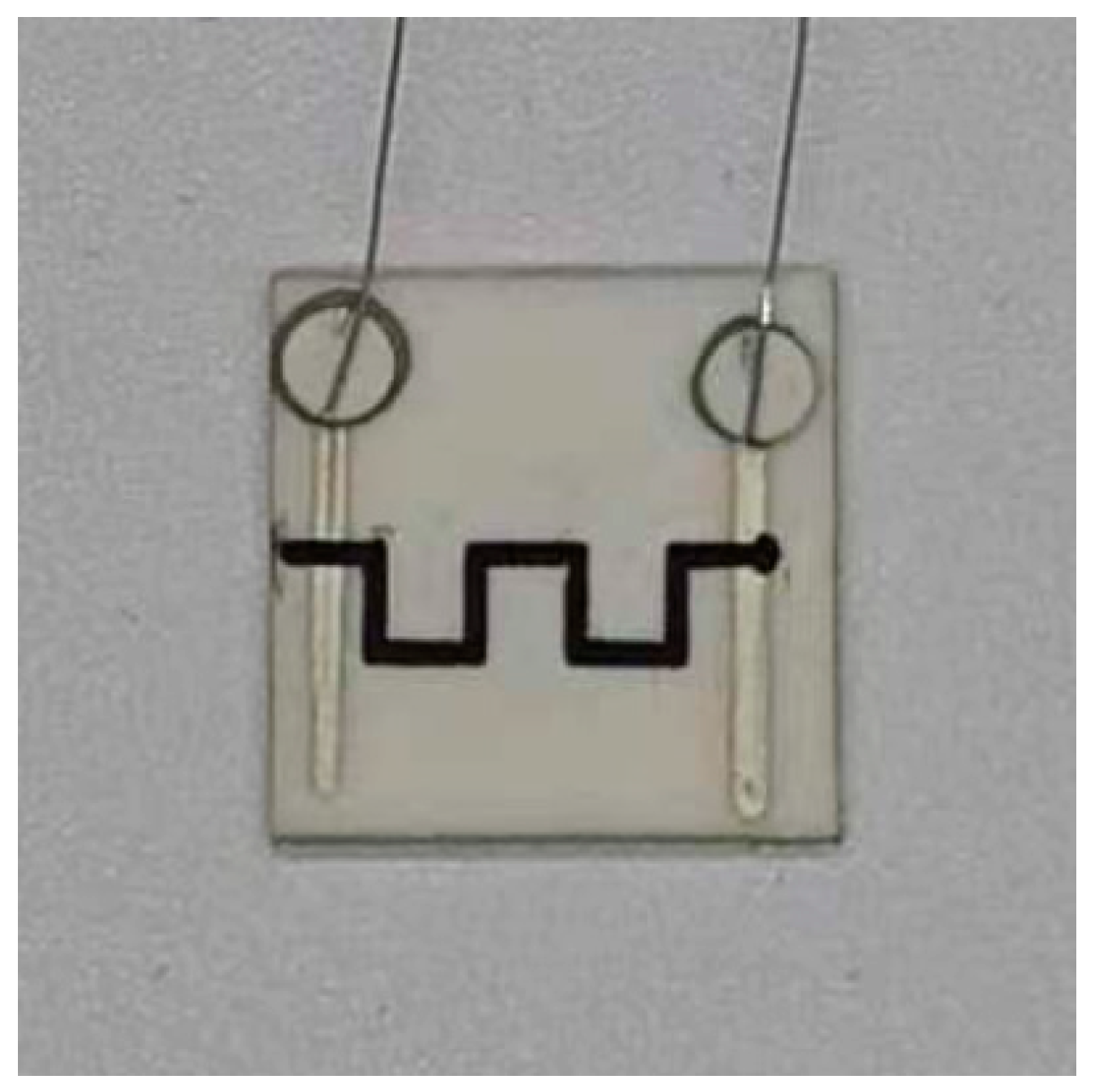

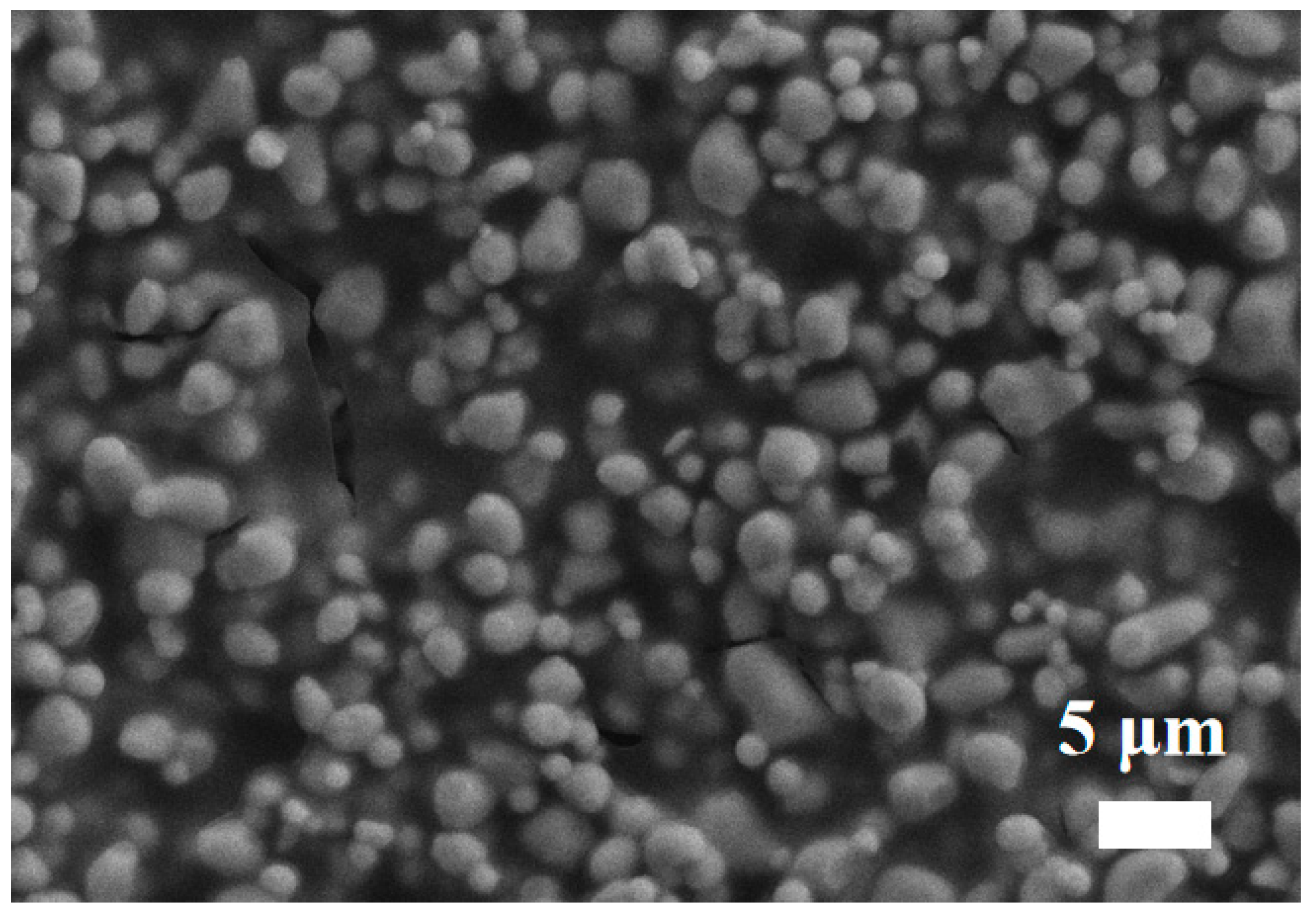

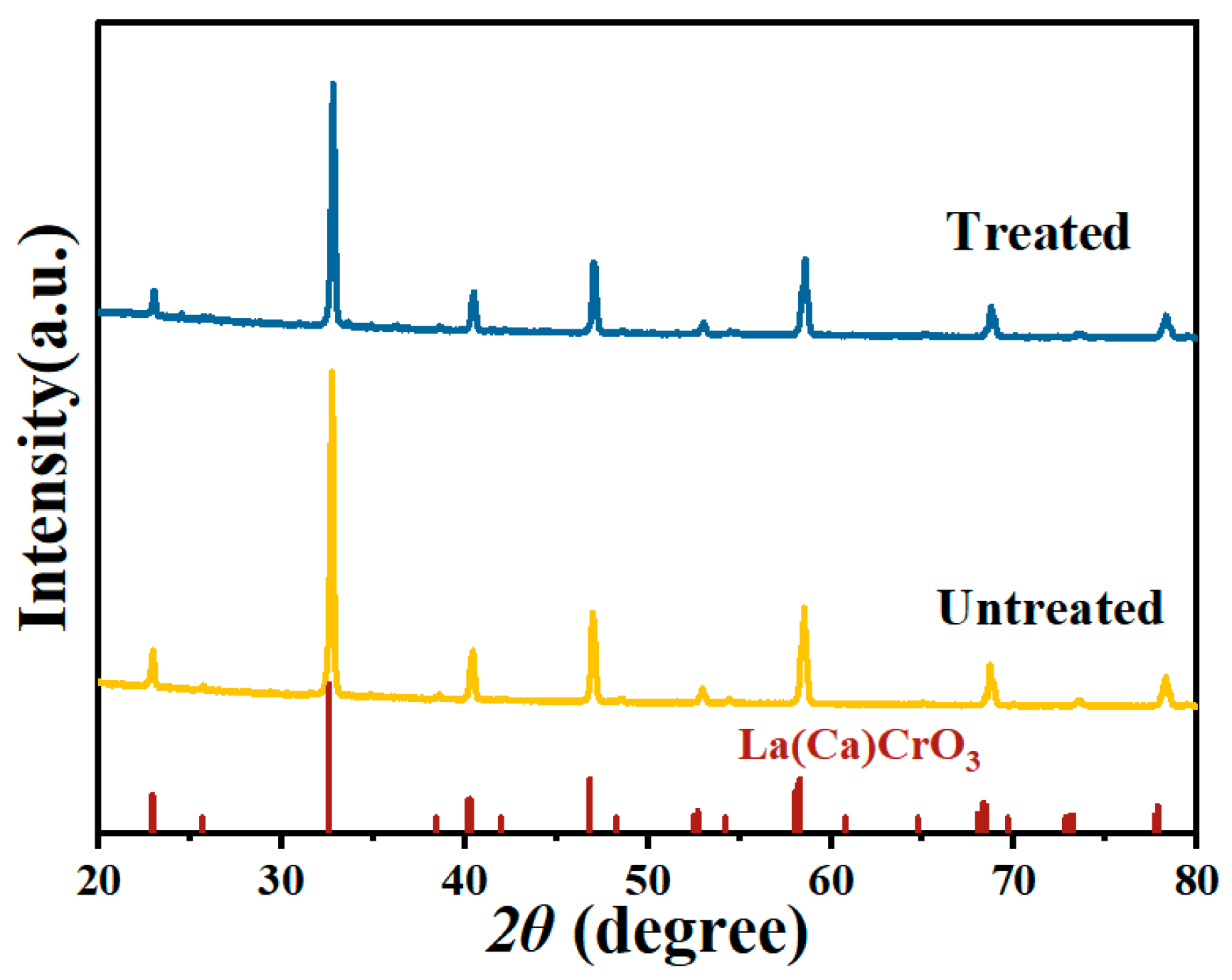

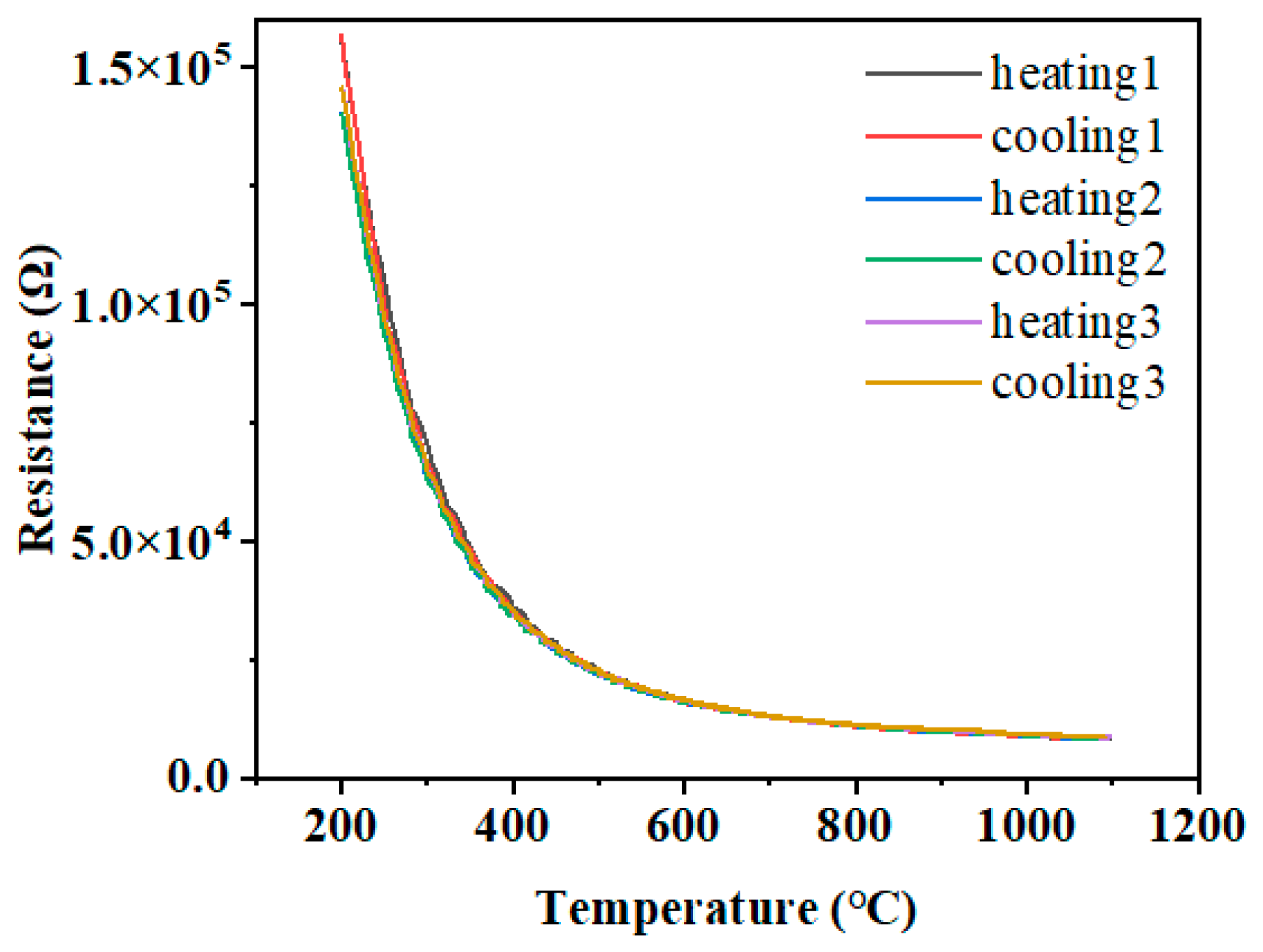

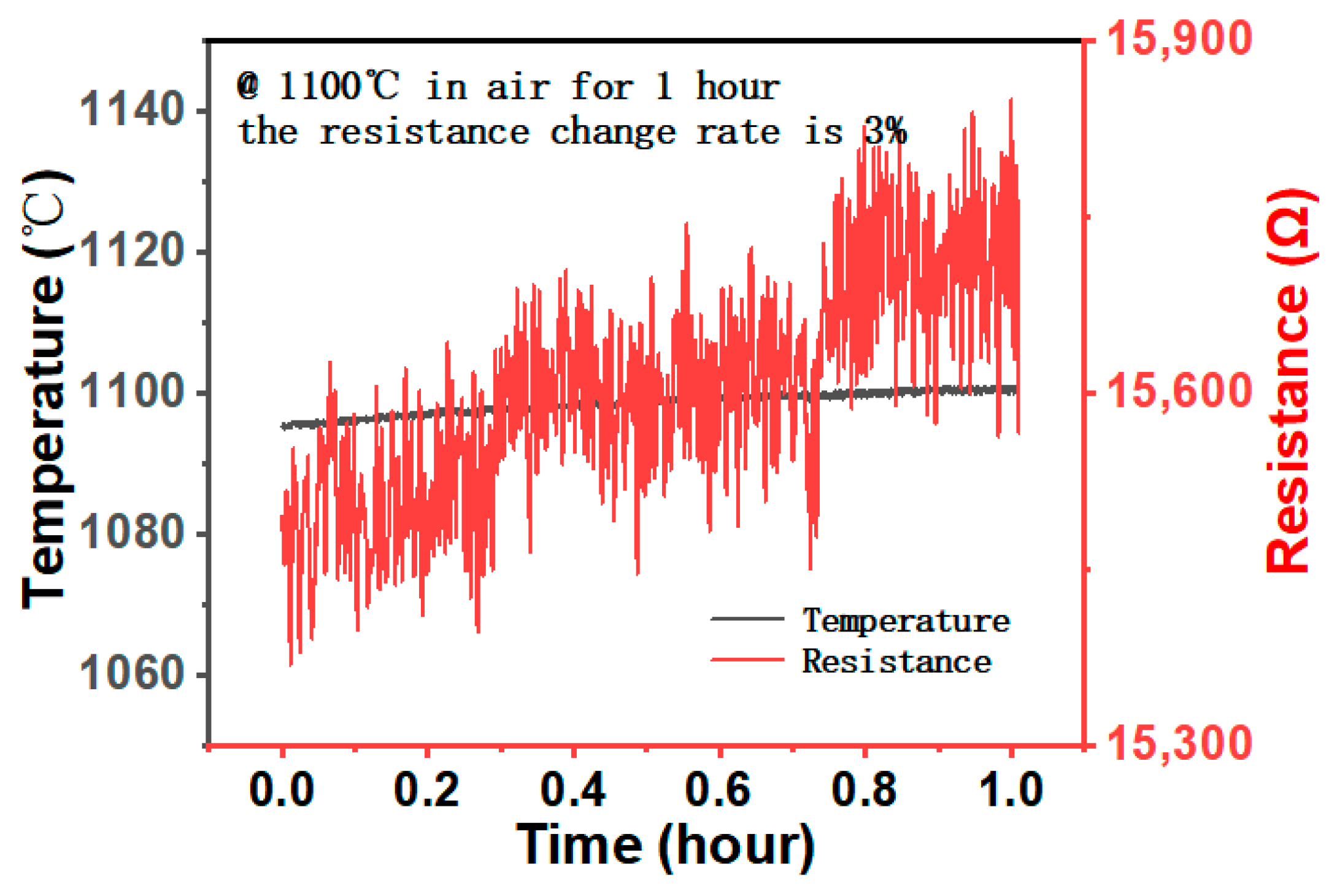

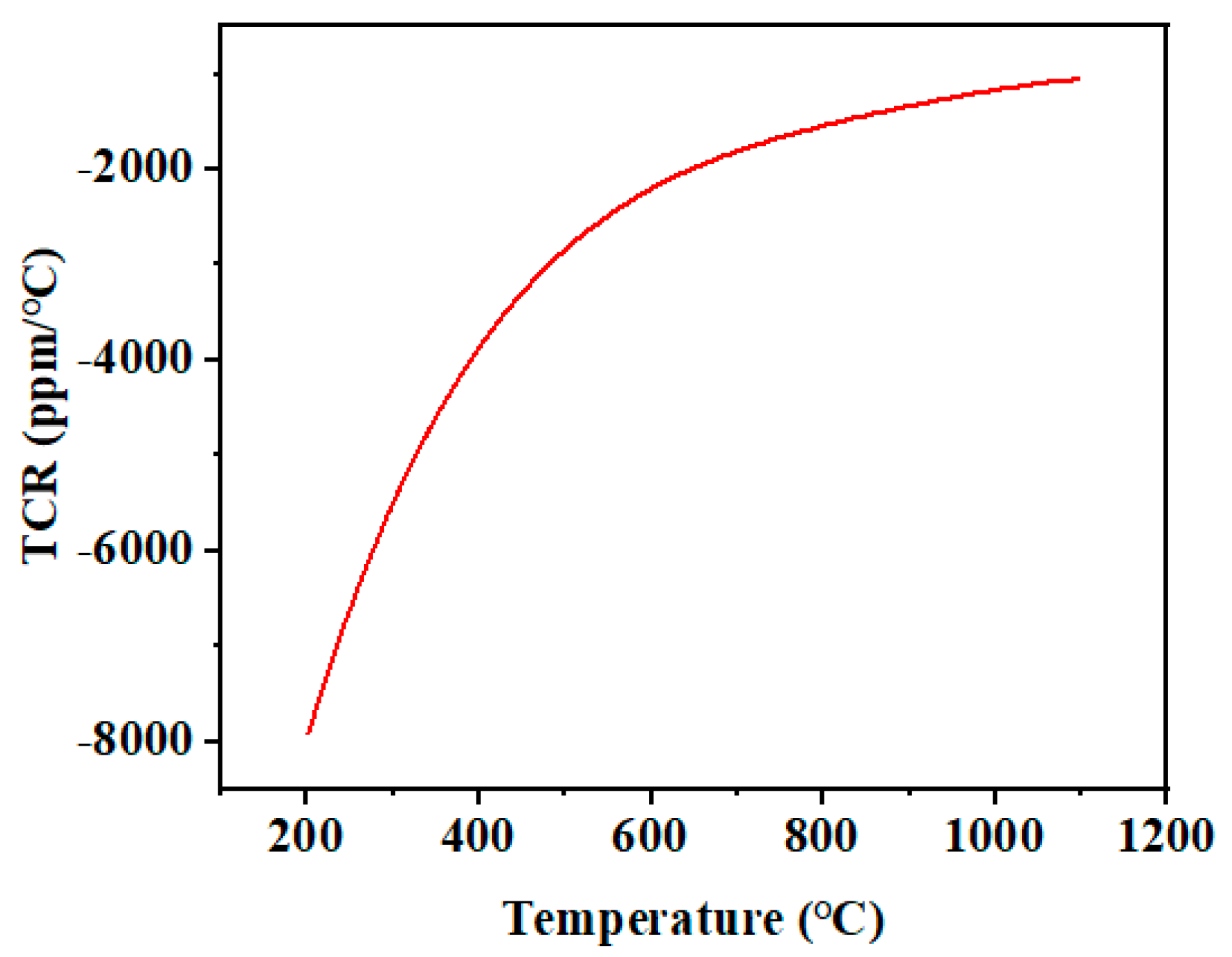
Disclaimer/Publisher’s Note: The statements, opinions and data contained in all publications are solely those of the individual author(s) and contributor(s) and not of MDPI and/or the editor(s). MDPI and/or the editor(s) disclaim responsibility for any injury to people or property resulting from any ideas, methods, instructions or products referred to in the content. |
© 2023 by the authors. Licensee MDPI, Basel, Switzerland. This article is an open access article distributed under the terms and conditions of the Creative Commons Attribution (CC BY) license (https://creativecommons.org/licenses/by/4.0/).
Share and Cite
He, G.; He, Y.; Xu, L.; Li, L.; Wang, L.; Hai, Z.; Sun, D. La(Ca)CrO3-Filled SiCN Precursor Thin Film Temperature Sensor Capable to Measure up to 1100 °C High Temperature. Micromachines 2023, 14, 1719. https://doi.org/10.3390/mi14091719
He G, He Y, Xu L, Li L, Wang L, Hai Z, Sun D. La(Ca)CrO3-Filled SiCN Precursor Thin Film Temperature Sensor Capable to Measure up to 1100 °C High Temperature. Micromachines. 2023; 14(9):1719. https://doi.org/10.3390/mi14091719
Chicago/Turabian StyleHe, Gonghan, Yingping He, Lida Xu, Lanlan Li, Lingyun Wang, Zhenyin Hai, and Daoheng Sun. 2023. "La(Ca)CrO3-Filled SiCN Precursor Thin Film Temperature Sensor Capable to Measure up to 1100 °C High Temperature" Micromachines 14, no. 9: 1719. https://doi.org/10.3390/mi14091719



